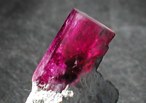Red Beryl / Bixbite Info
Back to Beryl / Red Beryl
General
Red Beryl / bixbite is a rare, expensive, red variety of beryl, not to be confused with bixbyite, a completely different, less valuable mineral.
Formation and Resources
Formation
During the late Cretaceous (100 - 65 mya) the younger ranges of the Rocky Mountains were created, and deep fractures appeared which reached deep into the crust. In course of volcanic activities (appr. 20 mya), five or more layers of volcanic topaz rhyolite lava flows covered areas in todays Utah. Then hot fluorine and beryllium-rich gases and vapors, rising through shrinkage cracks of the cooled lava, met groundwater resources near the surface. The water evaporated and left behind niches or miarolitic cavities and porous areas in which the remaining steam could react under low pressure and high temperatures (300° - 650° C) with the rising mineral-rich gases so that red beryl crystals could grow.
Resources
Red beryl occurs only in silica-rich, topaz-bearing rhyolites (volcanic origin), associated with bixbyite, hematite, orthoclase, pseudobrookite, quartz, and spessartine. Extremely rare gemmy mineral can only be found at three locations in the USA:
 |
| Wah Wah Mountains * |
Here red beryl occurs in fissures in a host rhyolite.
The crystals are found in a small area of only 900 x 1900 m.
* Photo by kind permission of © www.schweich.com, Tom Schweich.
 |
| Red Beryl from the Thomas Range * |
* Photo by kind permission of Sarah Sudcowsky.
3. "Black Range" in Sierra County / New Mexico where small crystals occur in white rhyolite, similar to the "Thomas Range". Here red beryls can be found at "Paramount Canyon" and "Round Mountain" / Taylor Creek Tin District.
In 2002, a pinkish, gemmy beryl was discovered in Madagascar, at first thought to be red beryl but then introduced as a new beryl variety, less valuable than bixbite: pezzotaite.
Color
The rare, red color of red beryl is caused by Mn2+, substituting the Al atoms in the beryl crystal. The best color is a clear, rich red ("stoplight") with some blue overtones. Red beryl colors vary from orange-red, rose, raspberry purplish to dark red, with medium tones.
Value
Red beryl is the rarest member of the beryl family. Unfortunately there is just a small production of gemmy crystals because of their rarity. Most faceted stones are under 1 ct, and most of them are more or less included or appear as opaque "bubble gum" quality. Nevertheless "bubble gum" colored red beryls are offered, sometimes in good quality.
Red beryl is estimated to be about thousand times worthier than gold! Faceted, clean stones with a "stop-light" color over 1 ct are extremely rare and priced as such, reaching sometimes over $10,000 / ct (in 2007).
The largest, yet recovered red beryl crystal was 1.4 x 3.4 cm (54 ct). The largest faceted stone (not clear) weighs 8.0 ct. Nevertheless the usual size of good, faceted red beryl is only 0.15 ct!
K. Hyslop, CEO of Gemstone Mining Inc.: "There is only one red emerald for every 150,000 diamonds, 12,000 - 15,000 emeralds, and 7,000 - 8,000 rubies. Only one woman in 3 million can own a 0.80 ct or larger red emerald. These goods are really fit for royalty, only one woman in 50 million could own a large red emerald necklace." (Source: "Red Emerald or Red Beryl" in The Gemstone Forecaster, Vol. 18 No.3)
Difference between Bixbite and Pezzotaite
Rough red beryl occurs as hexagonal crystals with all 6 sides equal, terminating in flat ends. Pezzottaite forms trigonal crystals terminating pyramid-shaped. Pezzottaite crystals are usually larger than red beryl. A red beryl's matrix is associated with white or grayish rhyolite. Pezzottaite is attached to gray granite. Usually red beryl isn't flawless if heavier than 1/10 ct. It is usually included, and shows internal fractures, veils of rhyolite, and/or black lumps. Pezzottaite is usually included with bubbles and internal fractures. Red Beryl has a refracture index of 1.567 - 1.580, pezzotaite has a refracture index of 1.601 - 1.620.
⇐ Intro Page ⇐ Gemstones ⇐ Red Beryl